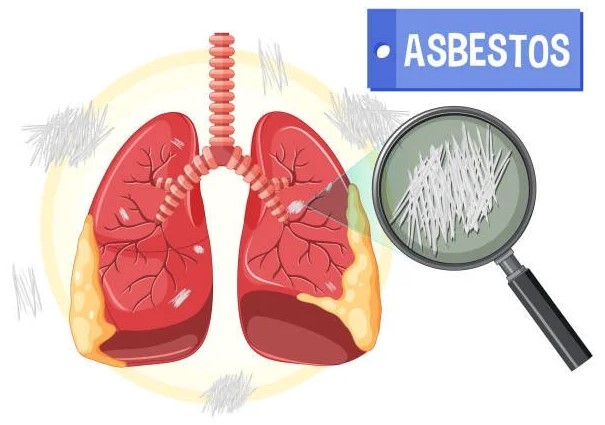Introduction to Asbestosis
Asbestosis is a chronic lung disease caused by inhaling asbestos fibers, leading to lung tissue scarring and long-term respiratory issues. The use of asbestos, a group of minerals found in the environment, has significantly declined due to its health risks, but its impact lingers.
Causes of Asbestosis
How Asbestos Fibers Cause Lung Damage
Asbestos fibers are tiny and easily inhaled, becoming trapped in the lungs. Over time, these fibers cause inflammation and scarring, impairing lung function.
Occupational Exposure
Jobs in construction, shipbuilding, and manufacturing historically involved high asbestos exposure. Workers often unknowingly inhaled fibers, putting them at risk for asbestosis.
Environmental Exposure
Although less common, living near asbestos mines or factories can lead to environmental exposure. Older buildings with asbestos-containing materials also pose risks.
Symptoms of Asbestosis
Early Symptoms
- Shortness of breath
- Persistent cough
- Chest tightness
Advanced Symptoms
- Severe shortness of breath
- Chest pain
- Finger clubbing (enlarged fingertips)
Diagnosis of Asbestosis
Medical History
Doctors begin with a thorough medical history, focusing on occupational and environmental exposure to asbestos.
Imaging Tests
Chest X-rays and CT scans help identify lung scarring and other abnormalities associated with asbestosis.
Pulmonary Function Tests
These tests measure lung capacity and the efficiency of oxygen exchange, crucial for diagnosing asbestosis.
Treatment Options for Asbestosis
Medications
While there is no cure, medications can manage symptoms. Anti-inflammatory drugs and bronchodilators help improve breathing.
Pulmonary Rehabilitation
This program includes exercise, education, and support to help patients manage their condition and improve quality of life.
Oxygen Therapy
For advanced asbestosis, oxygen therapy ensures adequate oxygen levels, alleviating breathlessness and improving sleep.
Surgical Options
In severe cases, lung transplantation may be considered. This option is rare and depends on the patient’s overall health.
Living with Asbestosis
Lifestyle Changes
Quitting smoking, avoiding respiratory irritants, and maintaining a healthy diet are crucial. Regular exercise helps improve lung capacity.
Coping Strategies
Support groups, counseling, and breathing exercises can help patients manage the emotional and physical toll of asbestosis.
Preventing Asbestosis
Workplace Safety Measures
Employers must enforce safety regulations, including proper ventilation and regular asbestos monitoring.
Proper Handling and Disposal of Asbestos
Specialized procedures for handling and disposing of asbestos prevent fiber release, protecting workers and the environment.
Personal Protective Equipment (PPE)
Wearing appropriate PPE, such as respirators and protective clothing, minimizes asbestos exposure risk.
Asbestos Regulations and Laws
Key Regulations
Laws like the Asbestos Hazard Emergency Response Act (AHERA) and Occupational Safety and Health Administration (OSHA) standards regulate asbestos use and removal.
Employer Responsibilities
Employers must provide training, conduct regular air monitoring, and ensure safe asbestos handling and disposal.
Complications Associated with Asbestosis
Respiratory Complications
Asbestosis increases the risk of chronic obstructive pulmonary disease (COPD) and other respiratory infections.
Increased Risk of Lung Cancer
Prolonged asbestos exposure significantly raises the risk of lung cancer and mesothelioma, a rare cancer affecting the lung lining.
Other Health Issues
Asbestosis can lead to heart problems due to decreased oxygen levels, and progressive lung scarring can cause respiratory failure.
Support and Resources
Patient Support Groups
Organizations like the Asbestos Disease Awareness Organization (ADAO) offer support and advocacy for asbestosis patients.
Professional Organizations
The American Lung Association provides resources and information for managing lung diseases, including asbestosis.
Financial Assistance
Patients may qualify for compensation through asbestos trust funds and legal claims against responsible companies.
The Future of Asbestosis Research
Current Research Trends
Researchers are exploring new treatments, including antifibrotic drugs and stem cell therapy, to slow disease progression and improve lung function.
Potential Treatments in Development
Innovative therapies, such as gene therapy and immunotherapy, hold promise for future asbestosis treatment options.
Common Myths About Asbestosis
Myth vs. Fact
- Myth: Only long-term exposure causes asbestosis.
Fact: Even brief exposure can lead to asbestosis. - Myth: Asbestos is banned everywhere.
Fact: Some countries still allow asbestos use in certain industries.
Importance of Accurate Information
Dispelling myths is crucial for raising awareness and promoting preventive measures.
Personal Stories
Testimonials from Asbestosis Patients
Personal stories highlight the daily challenges and triumphs of living with asbestosis, offering hope and inspiration.
Impact on Families
Families of asbestosis patients also face emotional and financial hardships, emphasizing the need for comprehensive support.
FAQs about Asbestosis
- What are the early signs of asbestosis? Early signs include shortness of breath, persistent cough, and chest tightness.
- How is asbestosis diagnosed? Diagnosis involves medical history, imaging tests, and pulmonary function tests.
- Can asbestosis be cured? There is no cure, but treatments can manage symptoms and improve quality of life.
- Who is at risk for asbestosis? Those with occupational or environmental asbestos exposure are at risk.
- What are the complications of asbestosis? Complications include respiratory issues, increased cancer risk, and other health problems.
Conclusion
Asbestosis is a serious lung disease with significant health implications. Understanding its causes, symptoms, and prevention strategies is vital for reducing risk and managing the condition. Continued research and support for affected individuals are essential in the fight against this debilitating disease.

